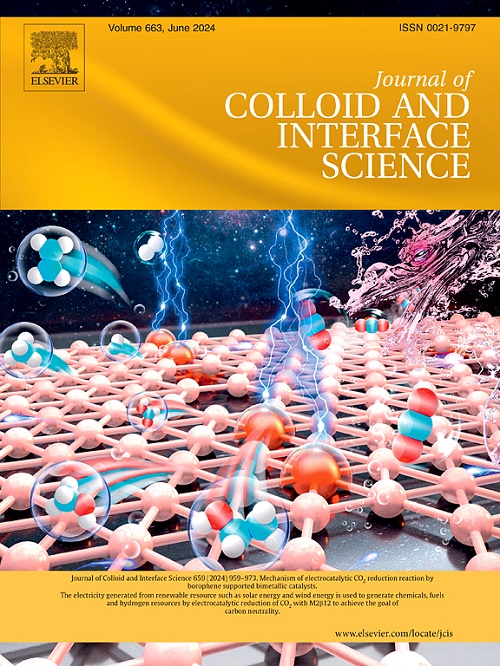微波介导的赤泥/生物炭活化过碳酸盐:氧空位和双热点效应的协同优化
IF 9.7
1区 化学
Q1 CHEMISTRY, PHYSICAL
引用次数: 0
摘要
高标准塑料清洗废水的尾水处理和赤泥(RM)资源回收是主要的挑战。在本研究中,成功制备了一种非均相微波响应催化剂RM/生物炭(RM/BC),以协同整合磁损耗和介电损耗,激活过碳酸钠(SPC)降解塑料添加剂邻苯二甲酸二乙酯(DEP)。表征分析表明,在600℃限氧条件下,杨叶粉完全碳化,RM中的Fe2O3被还原为FeO并进一步转化为Fe3O4,形成以非晶态碳和Fe3O4为主的复合材料。在RM/BC-600中,Fe3O4和无定形碳在微波辐射下通过磁损耗和介电损耗协同实现了双热点效应,并伴有富氧空位。在SPC活化过程中,羟基自由基(•OH)是主要的活性氧(ROS)。通过单因素和响应面优化,在40 μM DEP浓度、4.03 mM SPC投加量、6.24 g/L RM/BC-600投加量、87.2℃反应温度、100 W微波功率条件下,DEP的最佳去除率达到96.1%。原位FTIR/Raman光谱和EPR分析表明,RM/BC主要促进SPC分解为过氧化氢,氧空位催化过氧化氢生成•OH作为主要的ROS,并补充有碳酸盐自由基(•CO3−)、超氧自由基(•O2−)和单线态氧(1O2),而双热点效应加速了这一过程。HPLC-QTOF-MS鉴定了12个中间产物,并提出了合理的降解途径。ECOSAR软件预测降解产物的急性毒性降低,种子萌发试验证实RM/BC对土壤-植物系统的生态毒性最小。本研究通过绿色策略实现RM资源回收和危害缓解,通过DEP解毒和稳定性加强塑料废水处理。本文章由计算机程序翻译,如有差异,请以英文原文为准。

Microwave-mediated red mud/biochar activation of percarbonates: synergistic optimization of oxygen vacancies and dual hotspot effect
Tailwater treatment from high-standard plastic-cleaning wastewater and red mud (RM) resource recycling pose major challenges. In this study, a heterogeneous microwave-responsive catalyst, RM/biochar (RM/BC), was successfully prepared to synergistically integrate magnetic and dielectric losses for activation of sodium percarbonate (SPC) to degrade the plastic additive diethyl phthalate (DEP). Characterization analyses revealed that under oxygen-limited conditions at 600 °C, poplar leaf powder was fully carbonized, while Fe2O3 in RM was reduced to FeO and further transformed into Fe3O4, forming a composite dominated by amorphous carbon and Fe3O4. In RM/BC-600, Fe3O4 and amorphous carbon collaboratively enabled dual hot-spot effects under microwave irradiation via magnetic and dielectric losses, accompanied by enriched oxygen vacancies. Hydroxyl radicals (•OH) were identified as the dominant reactive oxygen species (ROS) in SPC activation. Through single-factor and response surface optimization, under conditions of 40 μM DEP concentration, 4.03 mM SPC dosage, 6.24 g/L RM/BC-600 dosage, 87.2 °C reaction temperature, and 100 W microwave power, the optimal DEP removal efficiency reached 96.1 %. In-situ FTIR/Raman spectroscopy and EPR analysis demonstrated that RM/BC primarily facilitated SPC decomposition to hydrogen peroxide, with oxygen vacancies catalyzing hydrogen peroxide to generate •OH as the main ROS, supplemented by carbonate radicals (•CO3−), superoxide radicals (•O2−), and singlet oxygen (1O2), while dual hot-spot effects accelerated this process. HPLC-QTOF-MS identified 12 intermediate products, and plausible degradation pathways were proposed. ECOSAR software predicted reduced acute toxicity of degradation products, and seed germination assays confirmed minimal ecotoxicity of RM/BC to soil-plant systems. This study achieves RM resource recovery and hazard mitigation via a green strategy, enhancing plastic wastewater treatment through DEP detoxification and stability.
求助全文
通过发布文献求助,成功后即可免费获取论文全文。
去求助
来源期刊
CiteScore
16.10
自引率
7.10%
发文量
2568
审稿时长
2 months
期刊介绍:
The Journal of Colloid and Interface Science publishes original research findings on the fundamental principles of colloid and interface science, as well as innovative applications in various fields. The criteria for publication include impact, quality, novelty, and originality.
Emphasis:
The journal emphasizes fundamental scientific innovation within the following categories:
A.Colloidal Materials and Nanomaterials
B.Soft Colloidal and Self-Assembly Systems
C.Adsorption, Catalysis, and Electrochemistry
D.Interfacial Processes, Capillarity, and Wetting
E.Biomaterials and Nanomedicine
F.Energy Conversion and Storage, and Environmental Technologies

 求助内容:
求助内容: 应助结果提醒方式:
应助结果提醒方式:


